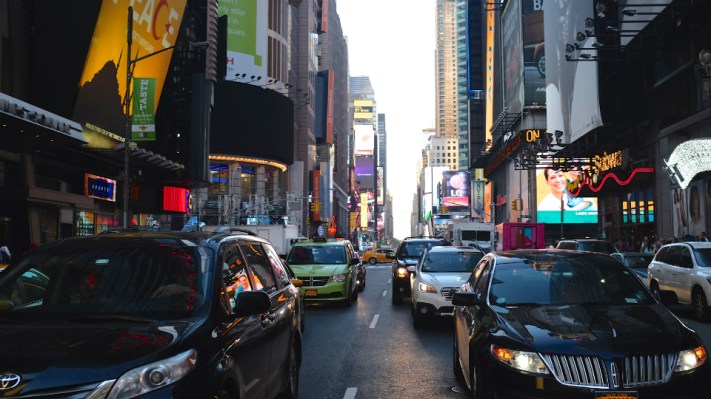We first told you about the soft launch of UberRUSH in the New York City area in April. Uber has now launched a pilot version of its merchant delivery service today in San Francisco, New York, and Chicago.
UberRUSH began experimenting with a way to help shoppers get same-day delivery of local products through both Uber drivers and bike couriers earlier this spring. New York City still deploys bike couriers and on-foot delivery through the service, Chicago will deliver all the retail things by car and SF will be a mix of both bike and car.
“In hundreds of cities across the globe, you can press a button and get a ride in minutes. Now, through UberRUSH, business owners can use that same technology to get customers pretty much anything in minutes,” reads the Uber blog post.
Think of it as Postmates, but for, well actually UberRUSH competes with Postmates. They both deliver food and various retail items from local businesses. Postmates also delivers from bigger retailers like Apple and recently announced a partnership with both Etsy and Kenneth Cole in the NYC area, whereas UberRUSH is just for local shops at the moment.
But, instead of keeping the orders on one platform, like Postmates and other courier services, Uber integrates UberRUSH directly into each merchant’s checkout process.
“Postmates is building a marketplace. We see this more as infrastructure,” head of UberEVERYTHING Jason Droege told a room full of press.
Customers ordering something for same-day delivery go to the merchant’s site and select UberRUSH to get same-day delivery during the checkout process. An email is then sent to the merchant to alert them that someone has placed an UberRUSH order and send them to the order fulfillment page where they can ready the order for pickup.
Both passengers and packages can now get picked up by Uber drivers, but they won’t be in the same car, according to the rideshare company.
Delivery couriers use the same Uber transportation technology that drivers use to pick up and drop off. They get an alert that an order has been placed, head to the pickup location to get the package and then take it to the address given. Customers then receive a text alert that the package is on its way or has been delivered, just like passengers get an alert that their Uber driver has arrived.
Despite a glut of on-demand food delivery services in San Francisco and New York and Uber’s own food delivery service UberEATS, much of the focus and examples used in the UberRUSH presentation were on ordering something to eat.
There’s a heavy focus on food for many on-demand services, and likely the biggest need in the delivery business. According to Postmate’s, about 75 percent of all its transactions are for food delivery. However, Uber believes its transportation infrastructure is what will set it apart in this space.
Postmates is building a marketplace. We see this more as infrastructure. Jason Droege, head of UberEVERYTHING
According to Uber’s preliminary information from a few thousand retailers in New York, the average delivery costs about $5 to $7 to deliver. This is a very similar price to Postmates, which starts at $5 and goes up at a nine percent additional service fee. According to Postmates, the average delivery price is around $7.
Postmates also rolled out a new on-demand delivery API this morning, with deliveries starting at $2.50 per pickup.
Uber did not want to disclose revenue figures for RUSH, but it will take a large amount of growth for it to be in the black – much more than just the current merchants in the program.
As mentioned above, UberRUSH is only available for local merchants at the moment. Some of the partners at this initial pilot launch include online store builder Shopify and Clover, a retail POS system for small businesses, which offers a way for Uber to easily integrate with those small business merchants.
Square is noticeably absent from that mix, though Uber did not comment on why that was when asked. Note that Square has its own on-demand food delivery service, Caviar. However, UberRUSH is also partnering with on-demand delivery service delivery.com – a very similar service that also delivers food and local retail items – in its pilot launch.
The main focus is on growth in this initial phase. There are already thousands of merchants in New York City that have integrated with UberRUSH, according to Uber.
The rideshare platform also has a successful transportation platform to support more as it grows. Postmates started out in food delivery, not transportation, but the delivery logistics are a big part of the business, particularly when it comes to efficiency.
Uber believes its transportation technology gives it a leg up in the delivery space and has gone about quietly testing this theory in one major metropolitan area for the past six or so months. Contrast this with Postmates API, which is separate from the marketplace and, like UberRUSH, also integrates within the store site. According to Postmates, its API service already works with more than 2,500 merchants in more than 40 U.S. cities at the moment, with a fleet of 18,000+ couriers delivering goods from merchants both large and small, since launching in December.
It’s a crowded space with a lot of moving parts to consider, and with a couple of large startups already established in many of the areas Uber no doubt intends to take on as it grows the new business. There are at least 13 different on-demand food delivery startups in San Francisco alone and that doesn’t seem to stop anyone from jumping in on the same thing.
It will be interesting to see not only how UberRUSH fares in the next little bit, but also who else tries to jump in (I’m still waiting for my Amazon delivery drone).
